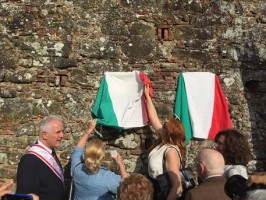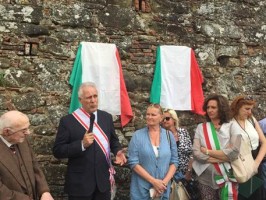Firenze – Jews and members of the resistance to the Nazi-fascist regime saved their lives in the Tuscan town of Lastra a Signa, thanks to the courage of Franciscan friars who welcomed them in their monastery, masquerading them as religious to rescue them from the Nazi raids.
To remember the heroism of those who risked their lives and saved defenseless persecuted, the Raoul Wallenberg Foundation declared the former monastery of the Franciscan friars of St. Lucia as “House of Life”. This temple is located in this town of 20,000 inhabitants, 12 kilometers from Firenze.
The Raoul Wallenberg Foundation is an educational NGO. Its president is Eduardo Eurnekian and its founder, Baruch Tenembaum.
The ceremony took place on May 10 in a moving meeting in which Eugenio Giani, president of the Italian region of Tuscany, civil Authorities and security forces of the city participated.
The climax occurred when Mr. Pier Damiano Marini, 91, who was saved by the friars, bursted into tears as he recalled the heroism of two friars who did not hesitate to challenge the Nazis to save him and his persecuted friends.
From September 1943 until August 1944, the walls of this ancient monastery hosted numerous people persecuted by the Fascists and the Nazis because of their origin or their opposition to the regime.
At first, the superiors of the Franciscan community, hesitated to welcome the persecuted, because of the consequences that could fall on the entire religious community if they were discovered by the Nazis.
However, they soon decided to open the monastery gates. The decision was taken thanks to the courage of the superior, Father Elpidio Perugini. Refugees, particularly Mr. Marini, recalled a poor friar, Benigno Salvadori, who devoted himself to attend their unexpected guests.
It was him who devised the getaway from the monastery to lead them to a safer place, another religious house in the Piazza Savonarola of Florence, wearing the refugees with the Franciscan habit.
During the operation, the fugitives were arrested by paratroopers of the German SS. Fray Benigno interposed between the Germans and the Persecuted to convince them that they were really religious. He was so eloquent, that the SS allowed them to pass.
Among the people who could save their lives in the monastery, was Giorgio Lasz, a Jewish engineer of Padua, who worked as director of the Italian railways company until the racial laws were enacted.
On September 8, according to the chronicle written by one of the friars of the Convent of St. Lucia, “given the ruthless persecution of the Jews,” the engineer Lasz “requested and obtained hospitality to our convent. He is a very gentle and polite man, very reverent with the priests, and very respectful of our religion. ”
In fact, Lasz had Monsignors in the Vatican as friends, who helped his daughter to receive a visa so that she could travel to Brazil and meet her husband.
Giorgio Lasz was welcomed at the convent from September 8th until November 1943, when he could travel hidden to Rome, where he was welcomed by another community of priests who served deaf-mute people.
Among those present at the ceremony was Patricia Finzi, the only granddaughter Giorgio Lasz had, who has been able to reconstruct the deeds that helped save the life of his grandfather and the heroic testimonies of the Franciscan friars.
The President of Tuscany, Eugenio Giani, documented the numerous instances of heroism that took place in the Italian region during the Second World War, both by the resistance as by the safety net that the Catholic Church interwove through its monasteries, convents, schools and parishes driven by the Archbishop of Florence, Cardinal Elia Dalla Costa, who was declared by Israel as Righteous Among the Nations, and whose cause is in the process of canonization.
Father Roberto Bellato, representative of the Franciscans of Tuscany, said that the plaque placed by the Raoul Wallenberg Foundation and the City Council cannot remain as just a memory of the past, but must become a lesson for the present, where the danger of violence or persecution still exists.
On behalf of President Eduardo Eurnekian and founder Baruch Tenembaum, Silvia Costantini, vice president of the Raoul Wallenberg Foundation, said that this celebration aims to make “memory of good” an inspiration to children and youth.
In fact, among those present, there was a group of adolescents who constitute the “Municipal Council of Boys”, an institution which democratically chooses a “Mayor” as a representative of the youngest of the city.
Ms. Silvia Costantini, unveiled the plaque on behalf of the Raoul Wallenberg Foundation. She said: “This plaque will remind all visitors and passersby that notwithstanding that the Holocaust was one of the darkest periods of humanity, many people opposed the terrible evil and made a difference.”
Translation: IRWF


